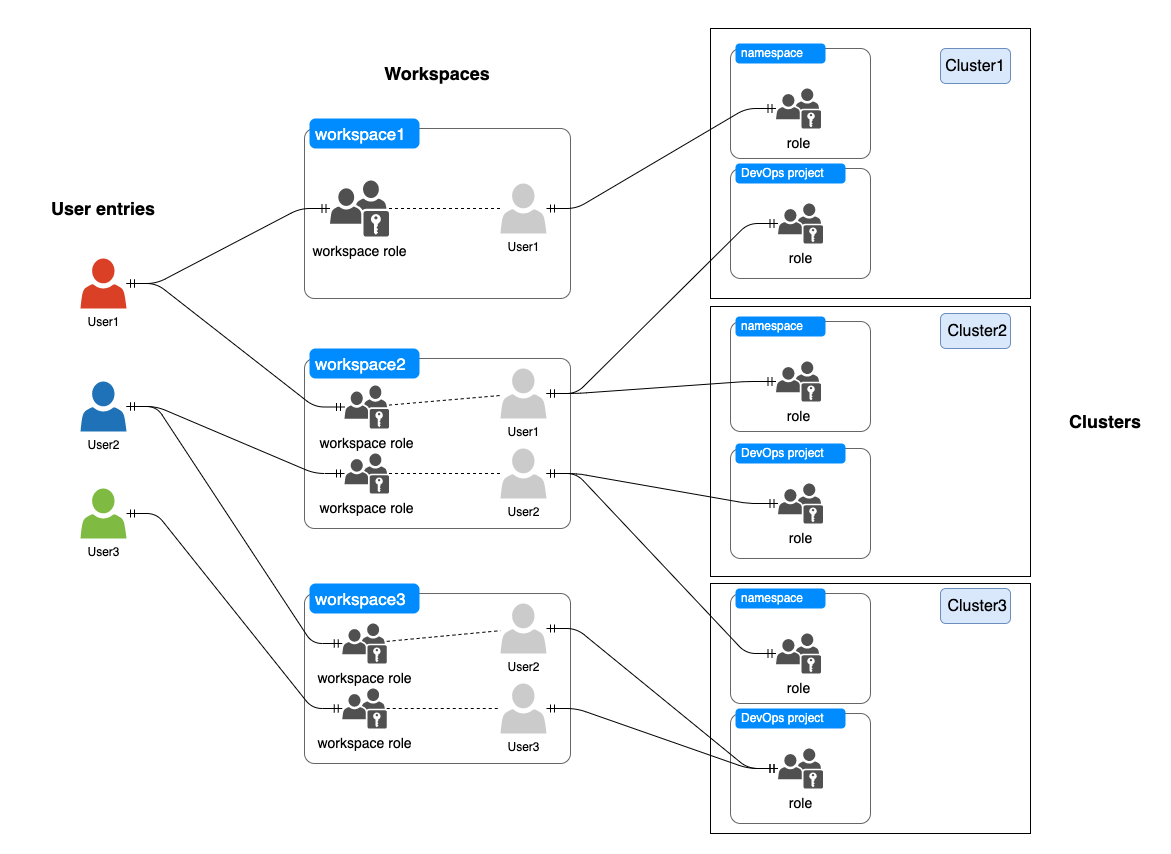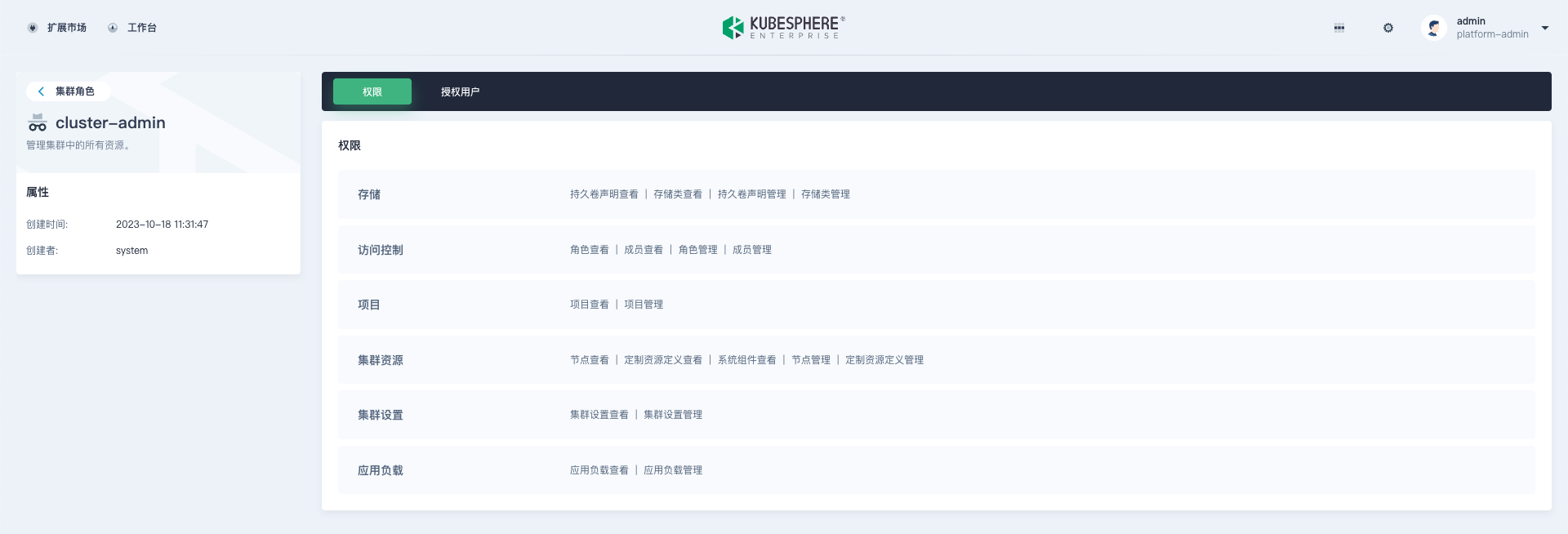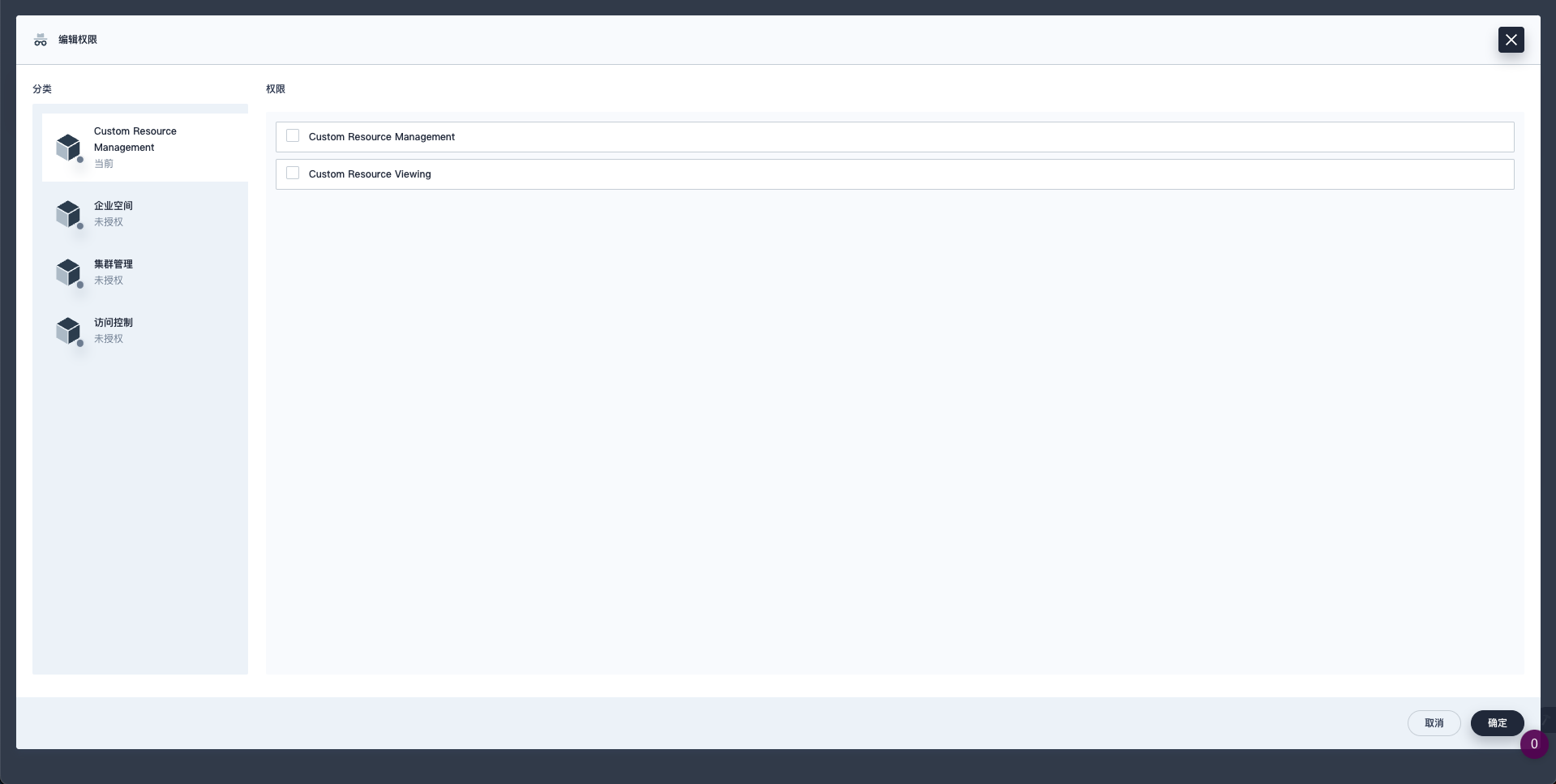Access Control
This section describes how to integrate KubeSphere access control into extensions.
Access control in KubeSphere
KubeSphere is a multi-tenant container management platform. Similar to Kubernetes, KubeSphere controls user permissions through Role-Based Access Control (RBAC) to achieve logical resource isolation.
In KubeSphere, the workspace is the smallest tenant unit, providing the ability to share resources across clusters and projects (i.e., namespaces in Kubernetes). Members in a workspace can create projects in authorized clusters and participate in project collaboration through invitation-based authorization.
Resources in KubeSphere are divided into four levels: platform, cluster, workspace, and project. All resources belong to these four levels, and access permissions for these resources are controlled by roles at each level.
Platform Roles: Mainly control user access to platform resources, such as cluster management, workspace management, and platform user management.
Workspace Roles: Mainly control access permissions of workspace members for resources under the workspace, such as project management, workspace member management, etc.
Project Roles: Mainly control access permissions for resources under the project, such as workload management, pipeline management, project member management, etc.
KubeSphere API
KubeSphere API follows the same design mode as Kubernetes API. It is a resource-oriented (RESTful) programming interface provided over HTTP. It supports the retrieval, creation, update, and deletion of main resources using standard HTTP verbs (POST, PUT, PATCH, DELETE, GET).
For certain resources, the API includes additional sub-resources, allowing for fine-grained authorization (e.g., separating the details and log retrieval for Pods). To facilitate or improve efficiency, these resources can be accepted and served in different representations.
Kubernetes API terminology
Kubernetes commonly uses standard RESTful terminology to describe API concepts:
- Resource Type: The name (
pods,namespaces,services) used in the URL. - All resource types have a concrete representation (their object schema) , known as the Kind.
- A list of instances of a resource type is called a Collection.
- A single instance of a resource type is called a Resource, often also referred to as an Object.
- For certain resource types, the API includes one or more sub-resources, which are represented as URI paths under the resource.
Most Kubernetes API resource types are objects: they represent concrete instances of a certain concept in the cluster, such as a Pod or a Namespace. A few API resource types are “virtual,” typically representing operations rather than the objects themselves, such as permission checks (using a POST to the subjectaccessreviews resource with a JSON-encoded SubjectAccessReview subject) or the Pod’s subresource eviction (used to trigger API-initiated eviction).
Object names
Every object you create via the API must have a unique name to allow for idempotent creation and retrieval. However, if virtual resource types are irretrievable or do not rely on idempotence, they may not have unique names.
Within a namespace, at any given moment, there can be only one object of a particular category with a given name. However, if you delete that object, you can create a new object with the same name. Some objects do not have namespace (e.g., nodes), so their names must be unique across the entire cluster.
API verbs
Almost all object resource types support standard HTTP verbs - GET, POST, PUT, PATCH, and DELETE. Kubernetes also uses its own verbs, which are typically written in lowercase to distinguish them from HTTP verbs.
Kubernetes uses the term list to describe a collection of returning resources, distinct from the retrieval of a single resource typically referred to as get. If you send an HTTP GET request with the ?watch query parameter, Kubernetes calls it watch instead of get.
For PUT requests, Kubernetes internally categorizes them as create or update based on the state of the existing object. Update is distinct from patch; the HTTP verb for patch is PATCH.
Resource URI
Resource types can be:
For KubeSphere platform: (apis/kapis)/GROUP/VERSION/*
For clusters: /clusters/CLUSTER/(apis/kapis)/GROUP/VERSION/*
For workspaces: (apis/kapis)/GROUP/VERSION/workspaces/WORKSPACE/*
For namespaces: /clusters/CLUSTER/(apis/kapis)/GROUP/VERSION/namespaces/NAMESPACE/*
Note: KubeSphere supports multi-cluster management for Kubernetes. As long as you add the cluster identifier as a prefix before the request path, you can directly access the member cluster through the API. Kubernetes core resources use /api instead of /apis and do not include the GROUP path segment.
Example:
/apis/iam.kubesphere.io/v1beta1/users/apis/cluster.kubesphere.io/v1alpha2/clusters/cluster/host/api/v1/pods/kapis/iam.kubesphere.io/v1beta1/workspaces/my-workspace/devopsprojects/cluster/host/api/v1/namespaces/my-namespace/pods
RBAC
Role-Based Access Control (RBAC) is a method of controlling access to computer or network resources based on the roles of users in an organization.
The RBAC authorization mechanism uses iam.kubesphere.io to drive authorization decisions, allowing you to dynamically configure policies through the KubeSphere API.
The RBAC API declares eight CRD objects: Role, ClusterRole, GlobalRole, WorkspaceRole, RoleBinding, ClusterRoleBinding, GlobalRoleBinding, and WorkspaceRoleBinding.
Role, ClusterRole, GlobalRole, and WorkspaceRole in RBAC contain a set of rules representing related permissions. These permissions are purely cumulative (there are no rules to deny a specific operation).
Role is used to restrict access to namespace resources; ClusterRole is used to restrict access to cluster resources; WorkspaceRole is used to restrict access to enterprise workspace resources; GlobalRole is used to restrict access to platform resources;
Here is an example of a Role located in the “default” namespace, which can be used to grant read access to Pods:
apiVersion: iam.kubesphere.io/v1beta1
kind: Role
metadata:
namespace: default
name: pod-reader
rules:
- apiGroups: [""]
resources: ["pods"]
verbs: ["get", "watch", "list"]
In the following example, RoleBinding grants the “pod-reader” Role to the user “jane” in the “default” namespace, which gives the user “jane” permission to read all Pods in the “default” namespace.
apiVersion: iam.kubesphere.io/v1beta1
# This RoleBinding allows "jane" to read Pods in the "default" namespace.
# You should have a Role named "pod-reader" in that namespace.
kind: RoleBinding
metadata:
name: read-pods
namespace: default
subjects:
# You can specify more than one "subject".
- kind: User
name: jane # "name" is case-sensitive.
apiGroup: iam.kubesphere.io
roleRef:
# "roleRef" specifies the binding to a certain Role or ClusterRole.
kind: Role # This field must be either Role or ClusterRole.
name: pod-reader # This field must match the name of the Role or ClusterRole you want to bind.
apiGroup: iam.kubesphere.io
Custom permission items
KubeSphere supports freely creating custom roles through permission items to achieve fine-grained access control.
RoleTemplate
RoleTemplate is a CRD provided by KubeSphere for declaring permission items. A permission item is the smallest unit of permission control, which is often used to define access permissions for a specific type of resource. Roles at different resource levels are composed of permissions. Based on permission items, users can flexibly create custom roles to achieve fine-grained access control.
In the Kubesphere user interface, users usually want to get other resources associated with the current resources they get. Place the permissions of a group of closely-related resources in a RoleTemplate to meet the usage requirements on the user interface.
Permission items of platform roles:
Permission items of workspace roles:
Permission items of cluster roles:
Permission items of project roles:
RoleTemplate examples
Assume that CRD custom-resource custom-resource-version is defined in the extension. We expect that it returns custom-resource-version when KubeSphere users view custom-resource in the user interface. The following YAML files create two custom permissions: global-custom-resource-view and global-custom-resource- manage, respectively authorizing users to view and create resources in the custom-resource type, where global-custom-resource-manage depends on global-custom-resource-view.
apiVersion: iam.kubesphere.io/v1beta1
kind: RoleTemplate
metadata:
name: global-custom-resource-view
labels:
iam.kubesphere.io/category: custom-resource-management
iam.kubesphere.io/scope: global
kubesphere.io/managed: 'true'
spec:
displayName:
en: Custom Resource Viewing
rules:
- apiGroups:
- custom-api-group
resources:
- custom-resource
- custom-resource-version
verbs:
- list
- get
- watch
---
apiVersion: iam.kubesphere.io/v1beta1
kind: RoleTemplate
metadata:
name: global-custom-resource-manage
annotations:
iam.kubesphere.io/dependencies: global-custom-resource-view
labels:
iam.kubesphere.io/category: custom-resource-management
iam.kubesphere.io/scope: global
kubesphere.io/managed: 'true'
spec:
displayName:
en: Custom Resource Management
rules:
- apiGroups:
- custom-api-group
resources:
- custom-resource
- custom-resource-version
verbs:
- '*'
RoleTemplate parameters
The following content describes how to configure parameters for custom permissions.
apiVersion: the API version for KubeSphere access control. The current version isiam.kubesphere.io/v1beta1.kind: the resource type of the custom permission. set the value toRoleTemplate.metadata: the metadata of the custom permission.name: the resource name of the custom permission.annotations:iam.kubesphere.io/dependencies: it will be displayed as a dependency on the Console, and when this permission item is selected, the dependent permission item will be automatically selected.iam.kubesphere.io/role-template-rules: it controls the permission rules of the Console, see Permission control on the frontend of Console below.
labels:iam.kubesphere.io/scope: the resource label of custom permissions. KubeSphere divides permissions into platforms, clusters, workspaces and project permissions.globalindicates that the current permission is at the platform level. The value can beglobal,cluster,workspaceandnamespace.iam.kubespere.io/category: custom-resource-management: mark the category of the permission item.iam.kubespere.io/managed: indicates whether the permission item is managed by KubeSphere.
specdisplayName: the display name of the custom permission, which supports i18n.en: display name in English.zh: display name in Chinese.
rules: the resources and operations allowed by the custom permission. This parameter is the actual definition of the content of custom permissions.apiGroups: the API group to which the resource type belongs. The value*indicates all API groups.resources: the resource type authorized to users, which can be CRD (for instance,custom-resource,custom-resource-versionin the examples in this section) or a Kubernetes default resource type (such asdeployment). The value*indicates all resource types at the permission level.verbs: the operations authorized to the user. The value*indicates all operations at the permission level. For more information about resource types, see Kubernetes official documentation.
Automatic aggregation of RoleTemplates
Aggregate RoleTemplates into roles using label matching method. The role contains a field called aggregationRoleTemplates, which includes a roleSelector field used to match the labels of RoleTemplates. RoleTemplates that match successfully are automatically aggregated into the role.
apiVersion: iam.kubesphere.io/v1beta1
kind: GlobalRole
metadata:
annotations:
## Add this annotation to enable automatic aggregation
iam.kubesphere.io/auto-aggregate: "true"
name: authenticated
aggregationRoleTemplates:
roleSelector:
matchLabels:
iam.kubesphere.io/aggregate-to-authenticated: ""
iam.kubesphere.io/scope: "global"
rules:
......
To aggregate a RoleTemplate into the “authenticated” GlobalRole mentioned above, you can add a specific label to the RoleTemplate. For example, add iam.kubesphere.io/aggregate-to-authenticated: '' to the RoleTemplate.
apiVersion: iam.kubesphere.io/v1beta1
kind: RoleTemplate
metadata:
name: global-custom-resource-manage
annotations:
iam.kubesphere.io/dependencies: global-custom-resource-view
labels:
iam.kubesphere.io/category: custom-resource-management
## Make sure the scope matches the role being aggregated
iam.kubesphere.io/scope: global
## Aggregate to the built-in role "authenticated"
iam.kubesphere.io/aggregate-to-authenticated: ''
spec:
displayName:
en: Custom Resource Viewing
rules:
- apiGroups:
- custom-api-group
resources:
- custom-resource
- custom-resource-version
verbs:
- *
Most built-in roles support automatic aggregation, reducing the configuration work for users.
For admin roles at different levels, they can automatically aggregate all RoleTemplates within their respective levels. For example, an admin of a namespace can automatically aggregate all RoleTemplates with the scope being “namespace”.
For non-admin roles, you can use the following labels to aggregate them to the corresponding roles:
Workspace
- iam.kubesphere.io/aggregate-to-viewer: ""
- iam.kubesphere.io/aggregate-to-regular: ""
- iam.kubesphere.io/aggregate-to-self-provisioner: ""
Global
- iam.kubesphere.io/aggregate-to-authenticated: ""
Cluster
- iam.kubesphere.io/aggregate-to-cluster-viewer: ""
Namespace
- iam.kubesphere.io/aggregate-to-operator: ""
- iam.kubesphere.io/aggregate-to-viewer: ""
Category
Category is used to mark the category of RoleTemplate. KubeSphere Console displays permission items in groups according to their categories, which correspond to the labels of RoleTemplate: iam.kubesphere.io/category: custom-resource-management。
apiVersion: iam.kubesphere.io/v1beta1
kind: Category
metadata:
name: custom-resource-management
labels:
iam.kubesphere.io/scope: global
kubesphere.io/managed: 'true'
spec:
displayName:
en: Custom Resource Management
Category parameters
apiVersion: the API version for KubeSphere access control. The current version isiam.kubesphere.io/v1beta1.kind: the resource type of the custom permission. Set the parameter value toCategory.metadata: the metadata for the custom permission.name: the resource name of the custom permission.labels:iam.kubesphere.io/scope: the resource label of custom permissions. KubeSphere divides permissions into platforms, clusters, workspaces and project permissions.globalindicates that the current permission is at the platform level. The value can beglobal,cluster,workspaceandnamespace.
specdisplayName: the display name of the custom permission, which supports i18n.en: display name in English.zh: display name in Chinese.
Create custom roles
After declaring RoleTemplate and Category, create custom roles:
Permission control on the frontend of Console
For the frontend, the RoleTemplate is crucial as it determines whether a page or button should be rendered when rendering pages for different tenants. The specific mechanism is as follows:
First, get the roles associated with a user at various levels (global role, cluster role, workspace role, role).
Based on the
aggregationRoleTemplatesfield of these roles, retrieve all RoleTemplates.Determine whether to render a page or button based on all the obtained RoleTemplates.
When entering a page, whether to render a specific page or button is determined based on RoleTemplates at different levels in the following order: global > cluster > workspace > namespace. If a higher-level RoleTemplate already includes the required permission items, the RoleTemplates at lower levels will not be checked.
Therefore, when developing interactive functionality for an extension, you need to consider the permission scope of tenants and what operations they are allowed to perform.
Menus Permission Settings
// menus relates to permission fields
const menus = [
{
name: 'hello-world', // name is required
ksModule: 'hello-world',
authKey: 'hello-world',
authAction:'view',
skipAuth: true,
}
];
Permission Filtering Effect
| Permissions | Fields | Type | Description | |
|---|---|---|---|---|
| 1 | Whether it is the platform administrator (platform-admin) | admin | boolean | If set to true, non-platform administrators will not be displayed. The default value is false. |
| 2 | Whether the module is installed in the current cluster | clusterModule | string | If not installed in the current cluster, it will not be displayed. Multiple modules can be specified using | as a separator. |
| 3 | Whether the module is installed or not | ksModule | string | Uninstalled modules are not displayed. |
| 4 | Whether the module is installed and has a specified annotation value | annotation | string | Modules without a specified annotation value will not be displayed. Note: annotation must be used in conjunction with ksModule. |
| 5 | Filter by permissions | authKey or name | string | If there is authKey, take authKey, otherwise take name. |
| 6 | Filter by permission items | authAction | string | The default value is view. |
| 7 | Skip permission control | skipAuth | boolean | It has the highest priority, if set to true, other configurations can be ignored. |
- RoleTemplate frontend permission control
metadata:
annotations:
iam.kubesphere.io/role-template-rules: '{"pipelines":"view"}'
iam.kubesphere.io/role-template-rules: '{"pipelines":"manage"}'
Parameters of RoleTemplate frontend permission control
iam.kubesphere.io/role-template-rules: control the annotations of frontend permissions,{key: action }is a JSON string.{key}: the key of the frontend permission, corresponding to theauthKeyornamefield of the frontend permission.{action}: see Actions of RoleTemplate frontend permission control.
Actions for RoleTemplate frontend permission control
view: with this field, the corresponding menus and pages are displayed. However, it only offers view permission, no operation permission.*,manage: view and operation permissions.create: create permission.delete: delete permission.edit: edit permission.- Other custom values (with frontend hardcoding).
Note:
create,delete,editare frontend permissions, they should work with the frontend code to add code such asaction: 'create'on the corresponding button, as in the following example.
// Code snippets
import { useActionMenu, DataTable } from '@ks-console/shared';}
const renderTableAction = useActionMenu({
autoSingleButton: true,
authKey,
params,
actions: [
{
key: 'invite',
text: t('INVITE'),
action: 'create', //It should be a specified action
props: {
color: 'secondary',
shadow: true,
},
onClick: openCreate,
},
],
});
return (<DataTable
// ... the other props
toolbarRight={renderTableAction({})}
/>)





